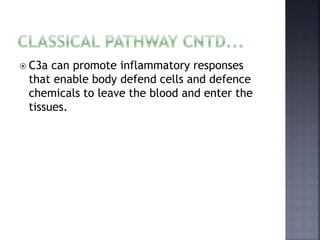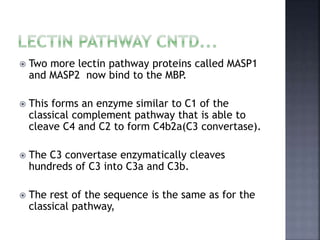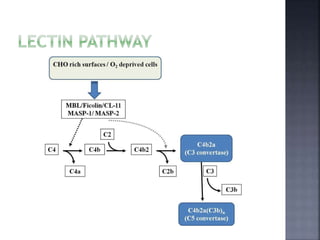16.complements!!!!!!!!!
- 1. Watch the video for more explanation https://oke.io/JRi9
- 2. Refers to the ability of these proteins to complement i.e augment the effects of other components of the immune system e.g. Antibody. Consists of a series of inactive precursor proteins that are activated which then activate the next protein in the sequence. Each precursor is cleaved into two or more components. Watch the video for more explanation https://oke.io/JRi9
- 3. Cell lysis ; such as bacteria, allografts, and tumour cells. Inflammatory responses i.e. generation of mediators that paticipatein inflammation and attract neutrophils. Opsonization; enhancement of phagocytosis. This is usually trigger by the major component of the complement system. Watch the video for more explanation https://oke.io/JRi9
- 4. Triggers inflammation. Chemo-tactically attracts phagocytes to infection sites. Promotes the attachment of antigens to phagocytes. Causes lysis of gram-negative bacteria and human cells displaying foreign epitopes. Plays a role in the activation of naive b lymphocytes. Removes harmful immune complexes from the body.
- 5. There are more than 30 components. They are named/ numbered according to how they were discovered. These components include; C1, C2, C3, C4, C5, C6, C7, C8, C9. Factor B, Factor D, Factor H, Factor I’ Properdin, C1 inhibitor, C4 binding protein, S protein.
- 6. Several complement components are proenzymes, which must be cleaved to form active enzymes. The critical step in the complement activation is the cleavage of C3 components by complement derived enzyme C3 convertase. The cleavage of C3 can be activated by 3 routes namely;
- 7. There are 3 pathways involved; Classical pathways Lectin pathway Alternate pathway
- 9. Also known as the usual pathway Antigen-antibody in the presence of complements destroy the invading organism. Considered to be part of the specific immune response as it requires the antibody for its initiation. The classical pathway recquires the IgM and IgG antibody for its activation. The other antibodies cant initiate classical pathway.
- 10. Binding of C1 to the antigen-antibody complex; the antigen-antibody complex is formed when the epitope of the antigen binds to the fab component of the IgM OR IgG. The fc component of the antibody binds to the C1q complement to activate it. The C1 complement has 3 subunits C1q, C1r and C1s
- 11. Cleavage of C4 by C1 The enzyme C1 activates two complements; C4 and C2. Enzyme C1 cleaves C4 into C4a and C4b . The C4b bind adjacent proteins and carbohydrates on the surface of the antigen.
- 12. Cleavage of C2 and formation of C3 convertase. C2 binds to the C4b and the enzyme C1 subsequently cleaves C2 into C2a and C2b. The classical complement pathway is now activated. The C4bC2a functions as a C3 convertase that can enzymatically cleave hundreds of molecules of C3 into C3a and C3b.
- 13. Cleavage of C3 by C3 convertase enzyme. The C4b2a functions as a C3 convertase enzyme. Cleaves hundreds of molecules of C3 into C3a and C3b. C3b and to a lesser extent, C4b, attaches antigens to phagocytes for opsonization. A portion of the C3b binds to proteins and polysaccharides on the surface of microbes, another to the CR1 receptors of phagocytes, b-lymphocytes and dendritic cells. This leads to improved phagocytosis.
- 14. C3a can promote inflammatory responses that enable body defend cells and defence chemicals to leave the blood and enter the tissues.
- 15. Formation of C5 convertase enzyme Some molecules of C3b bind to the C4b2a, to form C4b2a3b. This functions as C5 converting enzyme. Cleaves C5 into C5a and C5b. C5b binds to the cell surface. C5a diffuses away but before doing so has the some biological functions.
- 16. Formation of the membrane attack complex The C5b complex is quite labile and has about 2 mins to bind to C6 to form a C5b6 complex The C5b6 complex binds C7 and C8 to form a C5b678 complex. Upto 19 molecules of C9 can be added to one C5b678 complex. They assemble to form a pore some 100A in diameter. This is usually what is meant by membrane attack complement (MAC) .
- 17. Lysis due to osmotic imbalance. The pores formed by the MAC are large enough to allow the passage of ions, small molecules and water but too small to allow passage of proteins. There is therefore influx of water and loss of ion balance which leads to lysis by ‘bursting’ of the cell.
- 18. Also known as mannose binding lectin pathway. Independent of antibodies in its activation. Lectins are proteins that recognise and bind to specific carbohydrates targets. Very similar to the classical pathway. Mannan binding protein (MBP) is structurally similar to C1q. Instead of antibody binding to antigen on a pathogen, MBP which is always present in the serum, binds to mannose residues on the surface of pathogens such as certain salmonella, listeria and neisseria strains
- 19. Two more lectin pathway proteins called MASP1 and MASP2 now bind to the MBP. This forms an enzyme similar to C1 of the classical complement pathway that is able to cleave C4 and C2 to form C4b2a(C3 convertase). The C3 convertase enzymatically cleaves hundreds of C3 into C3a and C3b. The rest of the sequence is the same as for the classical pathway,
- 22. Also like the lectin pathway does not depend on the presence of antibodies. The C1, C4 and C2 complements are not involved in activation of the alternative pathway. This pathway uses different components to generate the C3 and C5 convertase enzymes.
- 23. Formation of C3 convertase. C3b is a highly labile protein which is continually undergoing hydrolysis to produce C3b and C3a. Some of the C3b bind to body’s own cells where its inactivated by surface regulatory proteins. Some binds to the surface of pathogens which unfortunately does not posses surface regulatory proteins. Factor B then combines with the cell bound C3b to form C3bB.
- 24. The factor B bound to the C3b is then cleaved by another alternative pathway protein, factor D to yield Bb and Ba. Ba diffuses away but Bb remained bound to C3b to form C3bBb which is equivalent to the C4b2a of the classical pathway. The C3bBb (C3 convertase enzyme) formed is stabilised by another alternative pathway protein called properdin to form C3bBbP that functions as a C3 convertase capable of enzymatically hundreds of molecules of C3 into C3b and C3a. This provides a powerful amplication loop.
- 25. Formation of C5 convertase Some of the C3b subsequently binds to some of the C3bBb to form C3bBb3b which is a C5 convertase equivalent to C4b2a3b in the classical pathway. C3bBb3b cleaves C5 into C5a and C5b components. The later stages of the complement pathway involving formation of the MAC proceed in exactly same way as for the classical pathway.
- 28. The complement cascade irrespective of how its activated generate a number of molecules that have a variety of biological activities. I. Cell lysis; this is mediated by the C5-9 forming the MAC as earlier discussed. I. Opsonization; promoting the attachment of antigens to phagocytes. C3b and to a lesser extent C4b can function as opsonins. phagocyte, B- lymphocytes and dendritic cells all have receptors for C3b on their surfaces called complement receptor type 1(CR1)
- 30. III. Chemotaxis; many complements components produced by the splitting of inactive precursors have chemotactic activity and therefore plays a role in recruiting cells to the site of inflammatory response. The most active is C5a which is chemotactic for neutrophils, monocytes and to a lesser extent, eosinophils. C3a is also chemotactic for eosinophils. IV. Triggering inflammation; C5a is the most potent complement protein triggering inflammation It causes neutrophils to release toxic oxygen radicals for extracellular killing. It also serves as chemo attractants for phagocytes. It enhances diapedesis of leucocytes. It induces fever Causes mast cells to release vasodilators such as histamine
- 31. To a lesser extent, C3a and C4a also promote inflammation. V. Clearance of immune complexes; C3b and to a lesser extent, C4b help to remove harmful immune complexes from the body. The C3b and C4b attach the immune complexes to CR1 receptors on erythrocytes. The erythrocytes then deliver the complexes to fixed macrophages within the spleen and liver for destruction. VI. Activation of B lymphocytes; serving as a second signal for activating naive B- lymphocytes.
- 32. The importance of regulating the complement system cant be over-emphasised due to its amplification and potentially tissue-damaging properties. This is achieved in 2 ways; Regulating the amount of complement activity. Regulating the site of complement activity.
- 33. Regulation of C3 convertase. Various proteins either inhibit the assemblage of C3 convertase or accelerate it dissociation. Regulators of C3 convertase assembly; complement receptor 1 (CR1), membrane co-factor protein (MCP) and C4b binding protein, are able o bind C4b and stop it binding to C2a, thereby inhibiting the formation of C4b2a. Another regulatory protein, factor 1 then cleaves C4b, resulting in irreversible inhibition of C4b2a assembly. CR1, MCP and a soluble protein, factor H, are able to bind C3b and stop it associating with factor B to form the alternate C3 convertase, C3bBb. Factor 1 then cleaves the C3b, irreversibly inhibiting assembly of C3bBb.
- 34. Factors causing decay of C3 convertase A membrane protein, decay accelerating factor, causes dissociation of C2a from C4b or C4b or C3b from Bb, inhibiting the classical and alternate C3 convertase respectively. Factor 1 then cleaves the membrane- bound C4b or C3b, making the inactivation irreversible.
- 35. Regulation of the membrane attack complex (MAC); a soluble protein called S-protein (vitronectin) binds the C5b-7 complex and stops it inserting into the cell membrane. A cell surface protein, CD59, inhibits MAC formation on the cell surface by blocking the binding of C8 and C9 to the C5b-7 complex.
- 36. Deficiency of C5-C8 and MBL Enhances susceptibility to Neisseria infections. Deficiency of C3 Severe recurrent pyogenic and respiratory tract infections. Inherited deficiency of C1 esterase inhibitors Angioedema’ Acquired deficiency of Decay accelerating factor. Paroxysmal nocturnal haemoglobinuria.




































